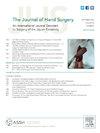Amyloid Biopsy During Endoscopic Carpal Tunnel Release: A Comparison of Tenosynovial and Antebrachial Fascia Specimens
IF 2.1
2区 医学
Q2 ORTHOPEDICS
引用次数: 0
Abstract
Purpose
Indications and techniques for biopsy to detect amyloid deposition during carpal tunnel release are evolving. Despite the popularity of endoscopic carpal tunnel release (ECTR), there is concern that this technique may be less able to detect amyloid. Our purpose was to compare the incidence of amyloid deposition detected during ECTR using two different biopsy sources: tenosynovial tissue and antebrachial fascia of the distal forearm.
Methods
This was a single-center retrospective investigation involving two hand surgeons. All primary, elective ECTR cases in adult patients between March 2022 and September 2024 were included if they underwent isolated tenosynovial or antebrachial fascia biopsy. Baseline demographics and surgical case characteristics were recorded. The primary comparisons of interest were the incidence of amyloid deposition for the tenosynovial and antebrachial fascia groups.
Results
A total of 195 cases were included. Eighty-seven percent were indicated for Tier 1 biopsy criteria. Of these cases, 145 (74%) underwent tenosynovial biopsy and 50 (26%) underwent antebrachial fascia biopsy. Mean age was 68 years, and 43% were women. Baseline demographics were similar between the groups, including mean age (67 vs 69 years) and the percentage of cases with diabetes (21% vs 26%). Overall, 27% of the included cases had evidence of amyloid deposition detected on biopsy performed during ECTR. Cases that had a tenosynovial biopsy had a significantly higher incidence of amyloid deposition (33%) compared with cases that underwent isolated antebrachial fascia biopsy (12%).
Conclusions
For primary ECTR cases, tenosynovial biopsy results in a significantly higher incidence of amyloid deposition (33%) compared with antebrachial fascia specimens (12%). Although open carpal tunnel release remains the gold standard for biopsy, if ECTR is being performed, biopsies should be obtained from the tenosynovial tissue rather than antebrachial fascia.
Type of study/level of evidence
Prognostic II.
内窥镜下腕管释放过程中淀粉样蛋白活检:肌腱滑膜和肱前筋膜标本的比较。
目的:在腕管释放过程中,活检检测淀粉样蛋白沉积的适应症和技术正在不断发展。尽管内窥镜腕管释放术(ECTR)很受欢迎,但有人担心这种技术可能无法检测到淀粉样蛋白。我们的目的是比较两种不同的活检来源(前臂远端肌腱滑膜组织和肱前筋膜)在ECTR中检测到的淀粉样蛋白沉积的发生率。方法:这是一项涉及两名手外科医生的单中心回顾性调查。所有在2022年3月至2024年9月期间的原发性、选择性ECTR病例,如果他们接受了孤立的肌腱滑膜或肱前筋膜活检,则纳入研究。记录基线人口统计学和手术病例特征。主要比较感兴趣的是肌腱滑膜组和肱前筋膜组淀粉样蛋白沉积的发生率。结果:共纳入195例。87%的患者符合一级活检标准。在这些病例中,145例(74%)行肌腱滑膜活检,50例(26%)行肱前筋膜活检。平均年龄为68岁,其中43%为女性。两组之间的基线人口统计数据相似,包括平均年龄(67岁对69岁)和糖尿病病例百分比(21%对26%)。总的来说,27%的病例在ECTR期间活检检测到淀粉样蛋白沉积。肌腱滑膜活检患者的淀粉样蛋白沉积发生率(33%)明显高于单独肱前筋膜活检患者(12%)。结论:对于原发性ECTR病例,肌腱滑膜活检结果显示淀粉样蛋白沉积的发生率(33%)明显高于臂前筋膜标本(12%)。尽管切开腕管释放术仍然是活检的金标准,但如果进行ECTR,则应从肌腱滑膜组织而不是肱前筋膜进行活检。研究类型/证据水平:预后II。
本文章由计算机程序翻译,如有差异,请以英文原文为准。
求助全文
约1分钟内获得全文
求助全文
来源期刊
CiteScore
3.20
自引率
10.50%
发文量
402
审稿时长
12 weeks
期刊介绍:
The Journal of Hand Surgery publishes original, peer-reviewed articles related to the pathophysiology, diagnosis, and treatment of diseases and conditions of the upper extremity; these include both clinical and basic science studies, along with case reports. Special features include Review Articles (including Current Concepts and The Hand Surgery Landscape), Reviews of Books and Media, and Letters to the Editor.

 求助内容:
求助内容: 应助结果提醒方式:
应助结果提醒方式:


